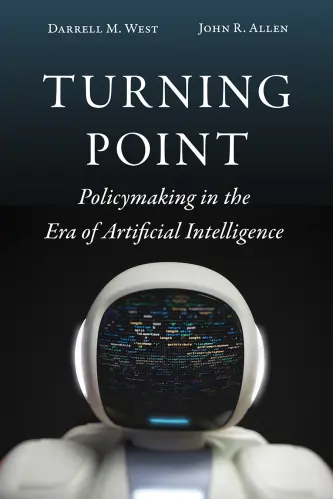This report from The Brookings Institution’s Artificial Intelligence and Emerging Technology (AIET) Initiative is part of “AI Governance,” a series that identifies key governance and norm issues related to AI and proposes policy remedies to address the complex challenges associated with emerging technologies.
Executive Summary
Government agencies are changing to become more efficient and effective. Set up for industrial-era operations, many public sector organizations are hierarchical, function on command and control principles, are labor intensive, and do not sufficiently employ digital tools for handling routine processes.
The results are high costs, unresponsive organizations, and public dissatisfaction. People see government as bloated and inefficient, and not serving the public interest. They worry whether government is up to the task of dealing with new challenges in public health, education, transportation, commerce, and national defense. Many individuals do not see government agencies rising to the needs of the 21st century and fear America is slipping behind other nations.
But there are new processes coming online that could improve this situation. In this paper, I focus on two applications: robotic process automation (RPA) and intelligent automation (also known as cognitive automation). Each is being deployed in federal government agencies and starting to alter how they function. I look at how these tools are being used, what the opportunities and risks are, and how to train the federal government workforce to utilize new technologies in a responsible manner.
What is Robotic Process Automation?
Robotic process automation refers to software or processes that enable the automation of routine administrative tasks. It develops rules for processing paperwork and has a series of “if/then” decisionmaking that handles tasks based on those guidelines. When key conditions are satisfied, the tool can pay invoices, process claims, or complete financial transactions.
These types of digital tools have been used for things from travel reimbursements, data collection, and claims processing to administrative compliance and invoice processing. Also included are “chatbots” that can answer common questions—for example, identifying opening and closing hours, explaining how to return damaged items, or providing assistance with filing complaints—and free human operators from having to answer the same inquiries over and over.
Sometimes, RPA tools have achieved significant cost and time savings. For example, KPMG worked with a technology company to develop a digital initiative that improved the processing of financial invoices. Rather than manually processing hundreds of thousands of invoices, it designed a tool that automatically populated forms with key information, provided corrections when necessary, and sent forms for human review when something complex or problematic came up. That allowed the organization to achieve cost savings and improve productivity by up to 70%.1
In another case, PwC worked with Boston Scientific to automate some aspects of its tax and finance operations. Analyzing a number of common transactions and data-entry processes, it was able to automate several different activities. Ultimately, PwC claims this process reduced overtime, boosted productivity, and saved around 3,900 person-hours each year. The result was higher employee and customer satisfaction, according to the firm.2
What is Intelligent Automation?
Intelligent automation (IA), also known as cognitive automation, is a type of RPA that includes artificial intelligence, machine learning (ML), or natural language processing (NLP). It can include data analytics and complex forms of analysis. IA is dynamic in nature and relies upon algorithms that have the ability to learn and adjust as they gain experience. Instead of being mechanical or static in nature, these tools can interpret information and make decisions that go beyond simple rule application.3
“With a lot of public data being unstructured in nature, intelligent automation is well-suited to make sense of text or image information that does not have uniform formatting or comes without much organization.”
Examples of IA include analyzing agency hearing texts to discern topics, handling complaint logs, and managing customer satisfaction. IA technologies also encompass data analytics that can track agency performance, a subset of tools that represent a way to interpret information in an increasingly sophisticated and efficient manner. With a lot of public data being unstructured in nature, IA is well-suited to make sense of text or image information that does not have uniform formatting or comes without much organization.
Examples of Federal Government Usage
There are a number of federal agencies that are implementing RPA tools. According to the General Services Administration’s 2020 RPA Playbook, there are more than two dozen federal departments actively deploying RPA.4 Their applications include acquisitions, automated payments, travel payments, and activity logging, among other things. Examples of federal bureaus engaging in this innovation include the following:
General Services Administration: This agency deployed an enterprise system called Truman that streamlined its federal acquisition process. The GSA writes:
“Truman’s goal is to allow the workforce to focus on negotiations, market research, customer and industry engagement. It helps the acquisition workforce to review new offer submissions under the agency’s flagship Multiple Award Schedule (MAS) program and helps us in two main ways. First, it pre-populates internal pre-negotiation and price-negotiation memorandums with information from vendor packages. Secondly, it conducts compliance checks with external databases.”5
Since the program was implemented, GSA claims that Truman has reviewed over 4,000 new MAS offers and saved over 5,000 hours of employee time.
Food and Drug Administration: Employees in the FDA’s Center for Drug Evaluation and Research found themselves spending a lot of time setting up meetings and performing repetitive tasks. They took advantage of RPAs to automate activities, such as drug intake forms for pharmaceutical firms. Each week, the center received thousands of these forms, which took a long time to process. Now through RPAs, the agency uses bots that pull information together to populate application materials. It also is using ML and NLP for regulatory review and risk assessment. That saves workers time and allows them to focus on higher-level activities beyond paperwork.6Social Security Administration: The SSA used to have 20,000 returned Supplemental Security Income payments each year, which took an average of three minutes to handle per payment. But after implementing an RPA system, workers were able to reduce their processing time to three seconds per payment.7Treasury Department: This department is using RPAs to improve its financial management systems. According to its officials, the unit is using “standardized solutions that promote financial integrity and operational efficiency across government.”8 That enables it to boost its management resources and reduce errors in financial reporting and analysis.
Defense Logistics Agency: The agency has 111 automation efforts underway as it seeks to gain the benefits of RPA. Some of these involve automation of post-award contracts, such as requests for extensions or information regarding contract details. DLA is automating these tasks so that humans don’t have to devote thousands of hours manually responding to each request. Its bots excel at “comparing data from multiple systems to look for discrepancies and errors” or “updating sales orders and invoices.”9
In addition, a 2021 survey from the American Council for Technology and the Industry Advisory Council (ACT-IAC) presents use cases from a dozen different agencies. The examples include: the Department of Agriculture (conservation records management); the Air Force (travel administration); Customs and Border Protection (email file conversion and indexing); the Department of Housing and Urban Development (process improvement); the Internal Revenue Service (personnel security); the Social Security Administration (payroll tax reconciliation); the Department of Veterans Affairs (enterprise service desk and benefits claims processing); and processes across various agencies (proposal management, sales orders, invoices, and process mining).10
In each of these improvements, ACT-IAC found that automation improved productivity and agency workflows and aided intelligent document processing. RPA was able to deploy bots that extracted text or data from various information sources and automatically generated relevant forms, such as invoices, proposals, or digital records. Each of those meant individuals did not have to manually transfer data across forms, saving many work hours.
Indeed, according to a George Mason University research project, there is a growing prevalence of RPA in the public sector. Its experts found widespread use for “data entry, data reconciliation, spreadsheet manipulation, systems integration, automated data reporting, analytics, and customer outreach and communications.” The university estimated that there was over “3,000 hours average in labor savings per bot.”11
However, there are far fewer agencies deploying IA. One analysis concluded that agencies have made “limited progress” due to the fact that IA requires more technical sophistication and most public sector organizations lack the required expertise. They simply don’t have the trained workforce to implement more complex algorithms or utilize ML or NLP.12
A federal report noted a number of obstacles to IA innovation and offered the following advice:
“Agencies should consider the following before incorporating advanced technologies into an RPA program: agency strategy for incorporating and implementing artificial intelligence within an organization; security approvals for the desired technology or application; any potential ethical and legal considerations surrounding the data that is used or the decision making that occurs within the workflow of the automation.”13
People’s Views about Automation
Americans generally hold positive attitudes about technology innovation, although they worry about the impact on jobs and what automation will mean for future skill requirements. For example, a 2020 Sykes Enterprises survey asked respondents, “If you were looking for a new job, would a company investing in new automation technologies make you more or less likely to apply there?” Overall, 77% said it would make them more likely to apply, and only 22% indicated it would make them less likely to want to work there.14
One of the reasons why so many appear open to automation is the amount of time workers spend on repetitive tasks. A 2019 NICE poll in the United States and United Kingdom found that “50% of employees spend well over half of the day on repetitive tasks.”15 They see RPA as a way to pull data from existing sources, fill out forms, check data accuracy, ensure compliance, and improve productivity. Currently, many of those tasks are performed manually and are time-consuming and inefficient.
At the same time, a number of people worry about job losses stemming from automation and understand the need to upgrade their job skills. A 2020 UiPath opinion survey found that 25% of office workers in the United States, United Kingdom, France, Germany, India, and Singapore “worry about losing jobs to automation,” and 83% say they “would feel more secure if their employers offered opportunities to learn new skills.” Around a third say they want to learn RPA skills, and many want to know more about AI and ML.16
Workforce Development
Given employee concerns regarding possible job losses and the need for upskilling, it is crucial that agency executives provide options for professional development and gaining the new skills required for emerging technologies.17 During a period of rapid technological change, it is vital that employers improve the ways for workers to engage in lifelong learning. The old model—where people invest in K-12 and higher education—must give way to one that also incorporates adult education at various points in people’s professional lives. It no longer is sufficient to get a college degree and not take any further courses or certificate programs. Training needs to be geared to the needs of the 21st-century digital economy.
“During a period of rapid technological change, it is vital that employers improve the ways for workers to engage in lifelong learning.”
As noted in a previous Brookings Institution report, common ways for professional development to take place include four-year universities, community colleges, private sector options, certificate programs, and/or online courses.18 Development opportunities need to be available both for technical and non-technical employees, although the needs will vary between these groups. Technical staff need to be up to date on the latest digital tools such as AI, ML, NLP, and data analytics. Each of those things is part of RPA and IA, so keeping abreast of important developments in these areas is crucial for federal employees.
Non-technical staff don’t need as detailed a background in technical subjects, but need to understand what questions to ask, what the workforce and agency ramifications are, how administrative processes may need to shift with the introduction of automated tools, and what the ethical risks may be. Here, the task is keeping them current on substantive problems related to RPA and IA, but not getting so immersed in the details that they lose sight of the big picture.
Rethinking Administrative Processes
With any new technology, it is important to alter administrative processes to take full advantage of the digital tools. One of the key determinants of institutional change is making sure administrative structures are in alignment with technology innovation. If digital tools do not correspond to agency missions, they are not likely to generate positive results. Agency leaders will end up disappointed with their investments and the public will complain about wasted dollars, dashed hopes, and unmet expectations.
New applications must fit the agency mission and make sense to those who are implementing the tools. If employees see value in the use of RPA bots, they will be far more likely to help with implementation and innovation. They need to understand that these developments will aid their workload, reduce error rates in data processing, relieve them of routine tasks, and help them be more effective at what they do.
“If digital tools do not correspond to agency missions, they are not likely to generate positive results.”
One cross-agency action that has promoted RPA innovation has been the formation of “community of practice” groups that share best practices and provide examples of successful implementation. These entities enable cross-bureau collaboration, and they can be helpful in explaining RPA’s benefits and providing tips to avoid implementation mistakes. Having federal agency groups of this sort further a culture of innovation and expedite RPA deployment across the national government.
Responsible Applications
It is important for administrative leaders to be responsible in how they develop and deploy RPA and IA.19 With emerging technologies, it is crucial to avoid problems that are known to undermine the accuracy and effective of innovation efforts. Among the key issues include a lack of representative data, a lack of transparency in data processing and analysis, and inadequate privacy and security protections.
Having representative data are vital for RPA and IA innovation. In order for bots to operate effectively and be free from bias, they need to rely on information that is accurate and representative of the users being served. Anything that reduces the representativeness or completeness of the data introduces potential errors into the processing and must be avoided.
In addition, having transparency in data processing and analysis is important. Both federal employees and the customers/clients being served must understand how bots operate and where they are drawing information. Being transparent about choices and processes aids the user experience and builds confidence in the applications.
Finally, there needs to be adequate privacy and security protections built into the applications. Having RPA and IA that respects the confidentiality of information and maintains the security of data compilation is of high priority. That means managers must be proactive about understanding and maintaining federal privacy policies and working to ensure bots safeguard data security. Failure to support either one of those principles will create problems that can undermine federal innovation activities.
An example of thoughtful security practices can be found in the GSA. The agency’s chief information security officer has published a security guide that outlines roles, responsibilities, and effective RPA security practices. Among other things, this document recommends the development of privacy impact assessments, deploying RPA bots in a test environment before large-scale adoption, having system and process owners for bots so there is clear accountability and responsibility, logging bot activities, providing secure credentialing for bots, and having bot annual reviews to monitor performance.20
Conclusion
To summarize, I argue that there are opportunities for RPA and IA in the federal government. A number of agencies have already moved to utilize new RPA applications, and they report positive gains from these deployments. Each represents a way to improve worker productivity and streamline administrative processing. There is evidence that these applications save worker time and reduce data error rates. Their adoption and deployment bring clear benefits into agency operations as long as they do not introduce biases, lack transparency, or fail to maintain federal privacy and security practices.
Thanks to James Seddon and Emily Skahill for their outstanding research assistance.
The Brookings Institution is a nonprofit organization devoted to independent research and policy solutions. Its mission is to conduct high-quality, independent research and, based on that research, to provide innovative, practical recommendations for policymakers and the public. The conclusions and recommendations of any Brookings publication are solely those of its author(s), and do not reflect the views of the Institution, its management, or its other scholars.
Microsoft provides support to The Brookings Institution’s Artificial Intelligence and Emerging Technology (AIET) Initiative. The findings, interpretations, and conclusions in this report are not influenced by any donation. Brookings recognizes that the value it provides is in its absolute commitment to quality, independence, and impact. Activities supported by its donors reflect this commitment.
-
Footnotes
- KPMG, “KPMG Powered Solutions for Technology Companies,” October, 2017.
- PwC, “Bots Help Restore Work/Life Balance: Boston Scientific Boosts Efficiency and Job Satisfaction with Robotic Process Automation,” September 20, 2017.
- Deloitte and Blue Prism, “Calculating Real ROI on Intelligent Automation,” 2020.
- Federal RPA Community of Practice, “RPA Program Playbook,” January 17, 2020.
- Jeff Lau, “The Future Is Now: Robotic Process Automation and the Federal Acquisition Service,” General Services Administration, July 21, 2021.
- Dave Nyczepir, “RPA is Helping with FDA’s Drug Evaluation and Research,” FEDSCOOP, September 20, 2019.
- U.S. Social Security Administration, “FY2020 Agency Financial Report,” undated, p. 50.
- U.S. Department of the Treasury, “FY2020 Capital Investment Plan,” undated, p. 15.
- Phil Goldstein, “DLA Continue to Gain Efficiencies Via RPA Technology,” FedTech, March 24, 2021.
- ACT-IAC, “Process Automation Product Survey,” March 15, 2021.
- David Rehr and Dorin Munteanu, “The Promise of Robotic Process Automation for the Public Sector,” George Mason University Center for Business Civic Engagement, June 22, 2021.
- Federal RPA Community of Practice, “The State of Federal RPA,” 2021.
- Federal RPA Community of Practice, “The State of Federal RPA,” 2021.
- Sykes Enterprises, “2020 Survey Report: How the Pandemic and Automation Are Shaping the Future of Work,” 2021.
- NICE, “RPA’s Research Reveals That Employees and Managers are Ready to Embrace Automation,” June 27, 2019.
- UiPath, “New Study Finds 86% of Employees Around the Globe Demand New Skills Training from their Employers,” June 1, 2020.
- Darrell M. West, The Future of Work: Robots, AI, and Automation, Brookings Institution Press, 2018.
- Darrell M. West, “Using Artificial Intelligence and Machine Learning to Reduce Government Fraud,” Brookings Institution, September 10, 2021.
- Darrell M. West and John R. Allen, Turning Point: Policymaking in the Era of Artificial Intelligence, Brookings Institution Press, 2020.
- General Services Administration Chief Information Security Office, “IT Security Procedural Guide: Robotic Process Automation Security,” March 31, 2020.
The Brookings Institution is committed to quality, independence, and impact.
We are supported by a diverse array of funders. In line with our values and policies, each Brookings publication represents the sole views of its author(s).







